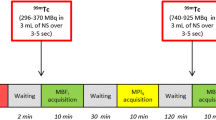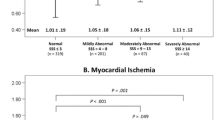Abstract
Background
Upper reference limits for transient ischemic dilation (TID) have not been rigorously established for cadmium-zinc-telluride (CZT) camera systems. We aimed to derive TID limits for common myocardial perfusion imaging protocols utilizing a large, multicenter registry (REFINE SPECT).
Methods
One thousand six hundred and seventy-two patients with low likelihood of coronary artery disease with normal perfusion findings were identified. Images were processed with Quantitative Perfusion SPECT software (Cedars-Sinai Medical Center, Los Angeles, CA). Non-attenuation-corrected, camera-, radiotracer-, and stress protocol-specific TID limits in supine position were derived from 97.5th percentile and mean + 2 standard deviations (SD). Reference limits were compared for different solid-state cameras (D-SPECT vs. Discovery), radiotracers (technetium-99m-sestamibi vs. tetrofosmin), different types of stress (exercise vs. four different vasodilator-based protocols), and different vasodilator-based protocols.
Results
TID measurements did not follow Gaussian distribution in six out of eight subgroups. TID limits ranged from 1.18 to 1.52 (97.5th percentile) and 1.18 to 1.39 (mean + 2SD). No difference was noted between D-SPECT and Discovery cameras (P = 0.71) while differences between exercise and vasodilator-based protocols (adenosine, regadenoson, or regadenoson-walk) were noted (all P < 0.05).
Conclusions
We used a multicenter registry to establish camera-, radiotracer-, and protocol-specific upper reference limits of TID for supine position on CZT camera systems. Reference limits did not differ between D-SPECT and Discovery camera.


Similar content being viewed by others
Abbreviations
- CAD:
-
Coronary artery disease
- CZT:
-
Cadmium-zinc-telluride
- LLk:
-
Low likelihood
- MPI:
-
Myocardial perfusion imaging
- SD:
-
Standard deviations
- SPECT:
-
Single-photon emission computed tomography
- TID:
-
Transient ischemic dilation
References
Stolzenberg J. Dilatation of left ventricular cavity on stress thallium scan as an indicator of ischemic disease. Clin Nucl Med 1980;5:289-91.
Weiss AT, Berman DS, Lew AS, Nielsen J, Potkin B, Swan HJC, et al. Transient ischemic dilation of the left ventricle on Stress thallium-201 scintigraphy: A marker of severe and extensive coronary artery disease. J Am Coll Cardiol 1987;9:752-9.
Mazzanti M, Germano G, Kiat H, Kavanagh PB, Alexanderson E, Friedman JD, et al. Identification of severe and extensive coronary artery disease by automatic measurement of transient ischemic dilation of the left ventricle in dual-isotope myocardial perfusion SPECT. J Am Coll Cardiol 1996;27:1612-20.
Iskandrian AS, Heo J, Nguyen T, Lyons E, Paugh E. Left ventricular dilatation and pulmonary thallium uptake after single-photon emission computer tomography using thallium-201 during adenosine-induced coronary hyperemia. Am J Cardiol 1990;66:807-11.
Abidov A, Bax JJ, Hayes SW, Cohen I, Nishina H, Yoda S, et al. Integration of automatically measured transient ischemic dilation ratio into interpretation of adenosine stress myocardial perfusion SPECT for detection of severe and extensive CAD. J Nucl Med 2004;45:1999-2007.
Alama M, Labos C, Emery H, Iwanochko RM, Freeman M, Husain M, et al. Diagnostic and prognostic significance of transient ischemic dilation (TID) in myocardial perfusion imaging: A systematic review and meta-analysis. J Nucl Cardiol 2018;25:724-37.
Slomka PJ, Berman DS, Germano G. Normal limits for transient ischemic dilation with (99m)Tc myocardial perfusion SPECT protocols. J Nucl Cardiol 2017;24:1709-11.
Lester D, El-Hajj S, Farag AA, Bhambhvani P, Tauxe L, Heo J, et al. Prognostic value of transient ischemic dilation with regadenoson myocardial perfusion imaging. J Nucl Cardiol 2016;23:1147-55.
Doukky R, Frogge N, Bayissa YA, Balakrishnan G, Skelton JM, Confer K, et al. The prognostic value of transient ischemic dilatation with otherwise normal SPECT myocardial perfusion imaging: A cautionary note in patients with diabetes and coronary artery disease. J Nucl Cardiol 2013;20:774-84.
Sharir T. Transient ischemic dilation: An old but not obsolete marker of extensive coronary artery disease. J Nucl Cardiol 2018;25:738-41.
Jameria ZA, Abdallah M, Dwivedi A, Washburn E, Khan N, Khaleghi M, et al. Computer derived transient ischemic dilation ratio for identifying extensive coronary artery disease using a CZT camera and imaging in the upright position. J Nucl Cardiol 2017;24:1702-8.
Slomka PJ, Patton JA, Berman DS, Germano G. Advances in technical aspects of myocardial perfusion SPECT imaging. J Nucl Cardiol 2009;16:255-76.
Miao TL, Kansal V, Glenn Wells R, Ali I, Ruddy TD, Chow BJ. Adopting new gamma cameras and reconstruction algorithms: Do we need to re-establish normal reference values? J Nucl Cardiol 2016;23:807-17.
Slomka PJ, Betancur J, Liang JX, Otaki Y, Hu LH, Sharir T, et al. Rationale and design of the REgistry of Fast Myocardial Perfusion Imaging with NExt generation SPECT (REFINE SPECT). J Nucl Cardiol 2018. https://doi.org/10.1007/s12350-018-1326-4.
Diamond GA, Forrester JS. Analysis of probability as an aid in the clinical diagnosis of coronary-artery disease. N Engl J Med 1979;300:1350-8.
Golzar Y, Olusanya A, Pe N, Dua SG, Golzar J, Gidea C, et al. The significance of automatically measured transient ischemic dilation in identifying severe and extensive coronary artery disease in regadenoson, single-isotope technetium-99m myocardial perfusion SPECT. J Nucl Cardiol 2015;22:526-34.
Germano G, Kavanagh PB, Slomka PJ, Van Kriekinge SD, Pollard G, Berman DS. Quantitation in gated perfusion SPECT imaging: The Cedars-Sinai approach. J Nucl Cardiol 2007;14:433-54.
Cerqueira MD, Weissman NJ, Dilsizian V, Jacobs AK, Kaul S, Laskey WK, et al. Standardized myocardial segmentation and nomenclature for tomographic imaging of the heart. A statement for healthcare professionals from the Cardiac Imaging Committee of the Council on Clinical Cardiology of the American Heart Association. Int J Cardiovasc Imaging 2002;18:539-42.
Horowitz GL, Altaie S, Boyd JC, Ceriotti F, Garg U, Horn P, et al EP28-A3c Defining, Establishing, and Verifying Reference Intervals in the Clinical Laboratory: Clinical and Laboratory Standards Institute; 2010.
Dodge Y. The Concise Encyclopedia of Statistics. New York: Springer; 2008. p. 437-9.
Wilcox RR, Erceg-Hurn DM, Clark F, Carlson M. Comparing two independent groups via the lower and upper quantiles. J Stat Comput Simul 2014;84:1543-51.
Rothman KJ. No adjustments are needed for multiple comparisons. Epidemiology 1990;1:43-6.
Gambhir SS, Berman DS, Ziffer J, Nagler M, Sandler M, Patton J, et al. A novel high-sensitivity rapid-acquisition single-photon cardiac imaging camera. J Nucl Med 2009;50:635-43.
Xu Y, Arsanjani R, Clond M, Hyun M, Lemley M Jr, Fish M, et al. Transient ischemic dilation for coronary artery disease in quantitative analysis of same-day sestamibi myocardial perfusion SPECT. J Nucl Cardiol 2012;19:465-73.
Katz JS, Ruisi M, Giedd KN, Rachko M. Assessment of transient ischemic dilation (TID) ratio in gated SPECT myocardial perfusion imaging (MPI) using regadenoson, a new agent for pharmacologic stress testing. J Nucl Cardiol 2012;19:727-34.
Mandour Ali MA, Bourque JM, Allam AH, Beller GA, Watson DD. The prevalence and predictive accuracy of quantitatively defined transient ischemic dilation of the left ventricle on otherwise normal SPECT myocardial perfusion imaging studies. J Nucl Cardiol 2011;18:1036-43.
Kakhki VR, Sadeghi R, Zakavi SR. Assessment of transient left ventricular dilation ratio via 2-day dipyridamole Tc-99m sestamibi nongated myocardial perfusion imaging. J Nucl Cardiol 2007;14:529-36.
Rivero A, Santana C, Folks RD, Esteves F, Verdes L, Esiashvili S, et al. Attenuation correction reveals gender-related differences in the normal values of transient ischemic dilation index in rest-exercise stress sestamibi myocardial perfusion imaging. J Nucl Cardiol 2006;13:338-44.
Marcassa C, Galli M, Baroffio C, Campini R, Giannuzzi P. Transient left ventricular dilation at quantitative stress-rest sestamibi tomography: Clinical, electrocardiographic, and angiographic correlates. J Nucl Cardiol 1999;6:397-405.
Chouraqui P, Rodrigues EA, Berman DS, Maddahi J. Significance of dipyridamole-induced transient dilation of the left ventricle during thallium-201 scintigraphy in suspected coronary artery disease. Am J Cardiol 1990;66:689-94.
Henny J, Vassault A, Boursier G, Vukasovic I, Mesko Brguljan P, Lohmander M, et al. Recommendation for the review of biological reference intervals in medical laboratories. Clin Chem Lab Med 2016;54:1893-900.
Abidov A, Berman D. Transient ischemic dilation associated with poststress myocardial stunning of the left ventricle in vasodilator stress myocardial perfusion SPECT: True marker of severe ischemia? J Nucl Cardiol 2005;12:258-60.
Abidov A, Germano G, Berman DS. Transient ischemic dilation ratio: A universal high-risk diagnostic marker in myocardial perfusion imaging. J Nucl Cardiol 2007;14:497-500.
Stohr EJ, Gonzalez-Alonso J, Shave R. Left ventricular mechanical limitations to stroke volume in healthy humans during incremental exercise. Am J Physiol Heart Circ Physiol 2011;301:H478-87.
Movahed A, Gnanasegaran G, Buscombe JR, Hall M. Integrating cardiology for nuclear medicine physicians: A guide to nuclear medicine physicians. New York: Springer; 2008.
Heller GV, Mann A, Hendel RC. Nuclear cardiology technical applications. New York: McGraw-Hill Education; 2009.
Ficaro EP, Lee BC, Kritzman JN, Corbett JR. Corridor4DM: The Michigan method for quantitative nuclear cardiology. J Nucl Cardiol 2007;14:455-65.
Garcia EV, Faber TL, Cooke CD, Folks RD, Chen J, Santana C. The increasing role of quantification in clinical nuclear cardiology: The Emory approach. J Nucl Cardiol 2007;14:420-32.
Acknowledgements
The authors want to thank all the people whose efforts allowed us to collect, process, and analyze the data in the National Institutes of Health-sponsored REFINE SPECT registry.
Disclosures
Drs. Germano, Berman, and Slomka participate in software royalties for QPS software at Cedars-Sinai Medical Center. Dr. Slomka has received research grant support from Siemens Medical Systems. Drs. Berman, Dorbala, Einstein, and EJ Miller have served as consultants for GE Healthcare. Dr. Dorbala has served as a consultant to Bracco Diagnostics; her institution has received grant support from Astellas. Dr. Di Carli has received research grant support from Spectrum-Dynamics and consulting honoraria from Sanofi and GE Healthcare. Dr. Ruddy has received research grant support from GE Healthcare and Advanced Accelerator Applications. Dr. Einstein and his institution have received research support from GE Healthcare, Philips Healthcare, and Toshiba America Medical Systems. Dr. EJ Miller has served as a consultant for Bracco Inc, and he and his institution have received grant support from Bracco Inc. Dr. Berman’s institution has received grant support from HeartFlow. All other authors have reported that they have no relationships relevant to the contents of this paper to disclose.
Author information
Authors and Affiliations
Corresponding author
Additional information
Publisher's Note
Springer Nature remains neutral with regard to jurisdictional claims in published maps and institutional affiliations.
The authors of this article have provided a PowerPoint file, available for download at SpringerLink, which summarizes the contents of the paper and is free for reuse at meetings and presentations. Search for the article DOI on SpringerLink.com.
Funding
This research was supported in part by Grant R01HL089765 from the National Heart, Lung, and Blood Institute/National Institutes of Health (NHLBI/NIH) (PI: Piotr Slomka). The content is solely the responsibility of the authors and does not necessarily represent the official views of the National Institutes of Health. Dr. Hu received the funding from Taipei Veterans General Hospital-National Yang-Ming University Excellent Physician Scientists Cultivation Program, No. 106-V-A-007.
Electronic supplementary material
Below is the link to the electronic supplementary material.
Rights and permissions
About this article
Cite this article
Hu, LH., Sharir, T., Miller, R.J.H. et al. Upper reference limits of transient ischemic dilation ratio for different protocols on new-generation cadmium zinc telluride cameras: A report from REFINE SPECT registry. J. Nucl. Cardiol. 27, 1180–1189 (2020). https://doi.org/10.1007/s12350-019-01730-y
Received:
Accepted:
Published:
Issue Date:
DOI: https://doi.org/10.1007/s12350-019-01730-y




